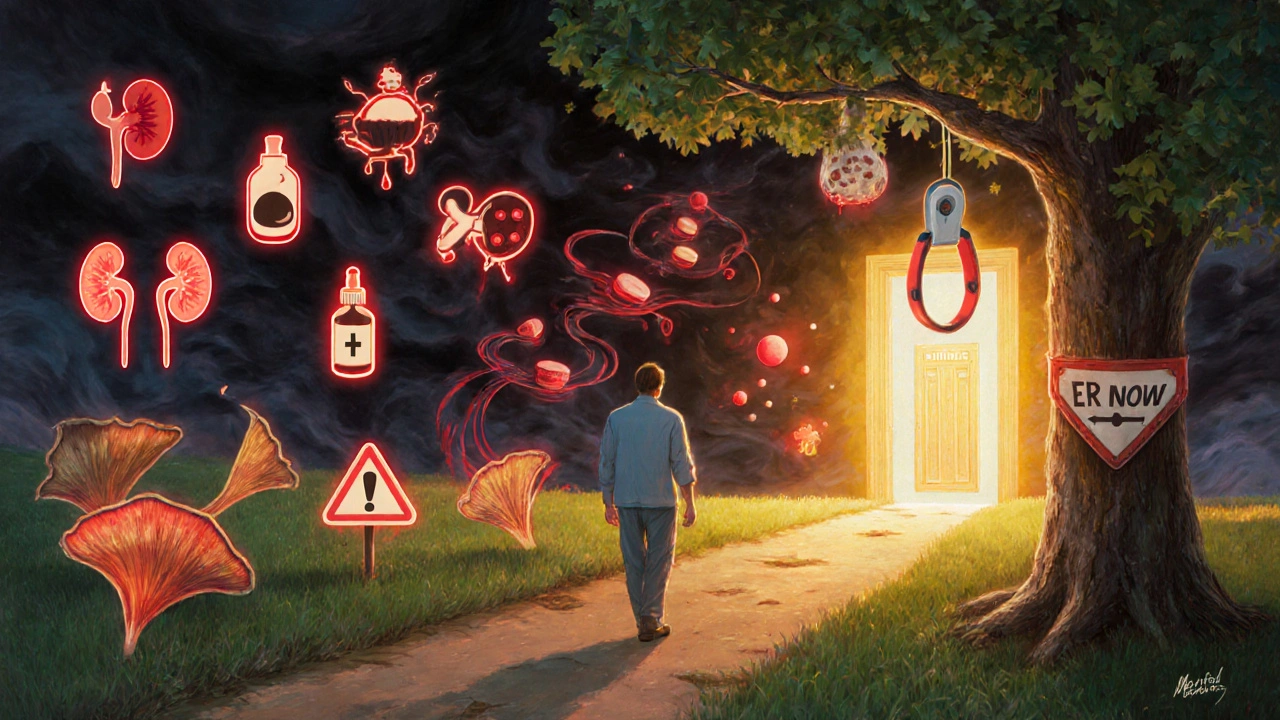HAS-BLED Risk Assessment Tool
What is the HAS-BLED Score?
This validated tool helps identify patients at higher risk of bleeding while on blood thinners. Each risk factor adds 1 point to your score. Higher scores mean higher bleeding risk.
Enter your information above to see your bleeding risk score.
When you're prescribed a blood thinner-whether it's warfarin, apixaban, rivaroxaban, or dabigatran-you're told it’s to prevent strokes or clots. But few patients are fully prepared for the real risk: severe bleeding. It doesn’t always come with a warning. One day you’re fine; the next, you’re vomiting blood, passing black stools, or bleeding out from a minor cut. And if you don’t act fast, it can turn deadly.
Why Blood Thinners Cause Severe Bleeding
Blood thinners don’t actually make your blood thinner. They slow down how quickly your blood clots. That’s good if you have atrial fibrillation, a replaced heart valve, or a history of deep vein clots. But it’s dangerous if you fall, hit your head, or develop an ulcer. Even small injuries can turn into life-threatening bleeds. The most common culprits are anticoagulants like warfarin and the newer DOACs (direct oral anticoagulants). Antiplatelet drugs like clopidogrel also raise bleeding risk, especially when used with anticoagulants. According to data from the Mayo Clinic, about 3.1% of people on DOACs have a major bleeding event in the first year. That might sound low-but when you’re one of them, it’s everything. And here’s the twist: you’re most at risk in the first 90 days. Studies show over 60% of serious bleeding episodes happen within the first three months of starting the drug. Why? Your body is still adjusting. Your kidneys are still clearing the drug at their own pace. And if you’re older, have kidney problems, or are taking other meds like aspirin or NSAIDs, your risk shoots up.Who’s Most at Risk?
Not everyone on blood thinners bleeds. But some people are far more likely to. The biggest red flags:- Age 75+: People over 80 have more than 3 times the bleeding risk of those under 60.
- Chronic kidney disease: Poor kidney function makes it harder for your body to clear DOACs, causing drug levels to build up. This increases bleeding risk by 2.3 times.
- History of bleeding: If you’ve had a GI bleed or brain bleed before, your chance of another one is 4.2 times higher.
- Multiple medications: Taking aspirin, ibuprofen, or even some herbal supplements like fish oil or ginkgo doubles your bleeding risk.
- Low-dose DOACs: Surprisingly, 58% of bleeding events happen in people on low-dose regimens-not the full dose. Why? Often, these patients are older or sicker, and the lower dose doesn’t fully account for their risk profile.
What Does Severe Bleeding Look Like?
It’s not always obvious. Many people wait too long because they don’t recognize the signs. The American Heart Association lists 12 key symptoms that demand immediate medical attention:- Nosebleeds lasting more than 10 minutes
- Red or brown urine (blood in urine)
- Black, tarry, or bloody stools
- Unexplained large bruises
- Coughing or vomiting blood
- Sudden, severe headache
- Dizziness, fainting, or weakness
- Blurred or double vision
- Unusually heavy menstrual bleeding
- Joint swelling or pain after minor trauma
- Wounds that won’t stop bleeding
- Confusion or trouble speaking

What to Do If Bleeding Happens
If you suspect severe bleeding, don’t wait. Don’t call your doctor’s office. Don’t check Drugs.com. Go to the emergency room now. At the hospital, they’ll check your vital signs, run blood tests, and possibly do a CT scan if there’s concern about brain or internal bleeding. For warfarin users, they’ll test your INR (a measure of how long your blood takes to clot). If it’s above 5, they’ll give you vitamin K and possibly fresh frozen plasma. For DOACs, it’s more complex. There are specific reversal agents:- Idarucizumab reverses dabigatran (Pradaxa). One vial costs $3,500 in the U.S.
- Andexanet alfa reverses rivaroxaban, apixaban, and edoxaban. A full treatment can cost over $12,500.
How to Prevent Bleeding Before It Starts
Prevention isn’t just about taking your pill. It’s about managing your life around it.- Get a HAS-BLED score: This is a simple tool doctors use to predict your bleeding risk. Points are added for high blood pressure, liver/kidney disease, stroke history, labile INR, elderly age, drugs/alcohol use. A score of 3 or higher means you need a safety plan.
- Know your drug levels: As of early 2024, the FDA approved the first point-of-care test to measure DOAC levels in the clinic. If you’re over 75, have kidney issues, or had a prior bleed, ask your doctor about testing your drug level 2-4 weeks after starting.
- Avoid NSAIDs: No ibuprofen, naproxen, or celecoxib. Use acetaminophen instead for pain.
- Use an electric razor: Skip the blade. Even a small nick can bleed for hours.
- Wear a medical alert bracelet: It tells paramedics you’re on a blood thinner. That changes everything in an emergency.
- Review all meds with your pharmacist: Even over-the-counter supplements can interact. Ginkgo, garlic, ginger, and fish oil all increase bleeding risk.
The Emotional Toll
Many patients live in fear. They avoid exercise. They panic over a nosebleed. They stop sleeping because they’re worried they’ll wake up bleeding. A 2022 Mayo Clinic survey found that 42% of patients on anticoagulants had at least one bleeding incident in the first year-and 28% didn’t realize it was serious until it was too late. Patient education makes a difference. A 2023 study in JAMA Internal Medicine showed that when doctors spent just 15-20 minutes teaching patients the warning signs, emergency visits for delayed bleeding dropped by 34%. That’s not just statistics. That’s lives saved.
What’s Next? New Hope on the Horizon
The future is getting better. In 2024, two new drugs-milvexian and asundexian-showed 20-25% less bleeding in early trials while still preventing clots. A universal reversal agent called Ciraparantag is in Phase III trials and could one day reverse all DOACs with a single injection. But for now, the tools we have are powerful-if used right. The key isn’t avoiding blood thinners. It’s using them wisely. Understanding your risk. Knowing the signs. Acting fast.Frequently Asked Questions
Can I still exercise if I’m on a blood thinner?
Yes-but avoid high-risk activities. Stick to walking, swimming, or stationary biking. Skip contact sports, rock climbing, or skiing. Wear protective gear if you ride a bike. Even minor falls can cause internal bleeding. Always tell your doctor before starting a new exercise routine.
What should I do if I miss a dose of my blood thinner?
Don’t double up. If you miss a dose of a DOAC (like apixaban or rivaroxaban), take it as soon as you remember-if it’s less than 12 hours late. If it’s more than 12 hours, skip it and take your next dose at the regular time. For warfarin, call your anticoagulation clinic. Missing doses can make your INR unstable and increase both clot and bleeding risk.
Is it safe to drink alcohol while on blood thinners?
Limit alcohol. More than one drink a day can increase bleeding risk, especially with warfarin. Alcohol affects how your liver processes the drug and can make your INR swing unpredictably. If you drink, stick to one glass of wine or beer occasionally-and never binge.
Do I need to get my blood tested regularly?
If you’re on warfarin, yes-weekly at first, then monthly once stable. For DOACs, routine blood tests aren’t required because dosing is fixed. But if you’re over 75, have kidney disease, or had a prior bleed, ask about DOAC level testing. New point-of-care tests can now measure drug levels in under 30 minutes.
Can I stop my blood thinner if I’m worried about bleeding?
Never stop without talking to your doctor. Stopping suddenly can cause a stroke or clot. If you’re scared of bleeding, talk to your doctor about your risks and whether a lower dose or different medication might be safer. Most people can manage their risk without stopping the drug entirely.

Bart Capoen
October 30, 2025 AT 02:42Been on apixaban for 3 years now. Never had a bleed, but I swear I check every pee for red spots. My wife thinks I’m crazy. Maybe I am. But I’d rather look paranoid than end up in the ER with a GI bleed and no warning.
Also, electric razor? Game changer. No more bleeding from shaving anymore. Small wins.
luna dream
October 31, 2025 AT 20:48They say it’s to prevent strokes… but who really benefits? Pharma. The FDA approves these drugs because they make billions. The real risk? They’re not testing them on old people long enough. I read a whistleblower report once-DOACs were pushed because they’re more profitable than warfarin. And now we’re the guinea pigs.
And don’t get me started on those $12,000 reversal agents. That’s not medicine. That’s a ransom note.
Linda Patterson
November 2, 2025 AT 04:44Anyone else notice how every single ‘expert’ here is pushing DOACs like they’re magic? Meanwhile, warfarin’s been around since 1954 and works fine if you’re disciplined. You want to avoid bleeding? Stop taking NSAIDs. Stop drinking. Stop being lazy about INR checks. It’s not the drug-it’s the patient. We’ve turned healthcare into a vending machine: take pill, feel better, ignore consequences.
And yes, I know my HAS-BLED score. It’s 5. I’m not surprised I’m still alive.
Jen Taylor
November 3, 2025 AT 17:24Okay, I just read this whole thing with tears in my eyes-because I’ve been there. My mom almost died from a DOAC-related bleed last year. She didn’t know black stools were a red flag. Thought it was ‘too much coffee.’
But here’s the beautiful part: after the ER, her cardiologist sat down with her for 20 minutes. Showed her pictures. Made her write down the 12 signs. She now teaches her book club about it. And guess what? No more panic attacks. Just awareness.
Education isn’t optional. It’s oxygen. Thank you for writing this. Seriously.
Shilah Lala
November 5, 2025 AT 16:43Wow. So much text. So many lists. So many ‘you must go to the ER’ warnings.
Meanwhile, I’m just sitting here wondering if I should’ve taken that aspirin for my headache. Or if my bruise is ‘unexplained’ enough to warrant a 911 call. Or if my nosebleed lasted 9 minutes and 58 seconds… did I just miss the cutoff?
My anxiety levels are now officially higher than my INR.
Christy Tomerlin
November 6, 2025 AT 00:16People are so scared of bleeding they forget they’re on blood thinners to avoid a stroke. That’s the trade-off. You can’t have both. You want to live? You risk bleeding. You want to be safe? You risk clotting.
Stop treating this like a horror movie. It’s medicine. Take it. Don’t take ibuprofen. Wear a bracelet. Get your kidney checked. Done.
Stop overthinking. Your body’s not a minefield. It’s a system. Treat it like one.
Susan Karabin
November 7, 2025 AT 07:11I used to think medicine was about fixing things
Now I know it’s about living with uncertainty
My pills keep me alive but they also keep me scared
Some days I just want to feel normal
But normal doesn’t exist anymore
So I walk. I breathe. I eat. I don’t check my stool every time
And some days that’s enough
That’s all I got
Lorena Cabal Lopez
November 7, 2025 AT 12:29Why is this even a thing? If you’re old and sick and on 5 different meds, why are you still getting DOACs? Just let nature take its course. These drugs are for people who want to live longer… but not necessarily better.
Also, why are we paying $12k to reverse a drug we were told was ‘safer’? Sounds like a scam to me.
Stuart Palley
November 7, 2025 AT 16:37My uncle died from a brain bleed on rivaroxaban. He was 78. Had kidney issues. Took aspirin for his arthritis. Didn’t tell his doctor. Didn’t know it was dangerous. The ER said ‘this happens’
That’s not acceptable. That’s negligence. We need mandatory patient education before prescribing these. Not a pamphlet. A 30-minute video with real people who bled out. Show them the blood. Show them the ICU. Make them feel it.
Otherwise we’re just sending people to die with a prescription in their pocket
Glenda Walsh
November 8, 2025 AT 21:14Hey, I’m a nurse, and I have to say-this is so important. But did you know that 60% of patients on DOACs don’t even know what their drug does? They just take it because the doctor said so. I had a patient yesterday who thought ‘blood thinner’ meant her blood was literally thinner like water. She was terrified she’d turn into a puddle.
Also, if you’re on warfarin and you eat kale every day, your INR will go nuts. Talk to your pharmacist. Please. I’m begging you.
Tanuja Santhanakrishnan
November 10, 2025 AT 00:00I’m from India and we don’t have access to reversal agents like idarucizumab. Our hospitals use PCCs or fresh frozen plasma. It’s slower, but it works. And guess what? People still survive. Because they recognize the signs early. Because their families know what to do.
It’s not about money. It’s about awareness. Teach your grandma. Teach your neighbor. Tell your cousin who’s on a blood thinner. That’s how we save lives.
And yes, I’ve seen people live after a GI bleed. It’s not magic. It’s timing.
Natalie Eippert
November 11, 2025 AT 14:56As a former FDA advisor I can tell you this: DOACs were fast-tracked because they’re easier to prescribe. No INR. No monitoring. But the real cost is in the emergency departments. We’re seeing a 40% increase in bleeding-related ER visits since 2018. And most of these patients had no idea what they were taking.
There’s a systemic failure here. Not just individual negligence. The system encouraged convenience over safety.
And now we’re cleaning up the mess.
kendall miles
November 12, 2025 AT 12:40They’re lying about the reversal agents. They’re not that effective. The data’s manipulated. I’ve seen the internal trials. The bleeding still happens. The drugs just mask it longer. And the cost? That’s not for patients. That’s for insurance companies to pay. We’re being sold a lie.
Also, why do they call it ‘direct oral anticoagulant’? Sounds like a sci-fi drug. Probably from a lab in Switzerland. I bet they don’t even test it on real people.
Gary Fitsimmons
November 14, 2025 AT 09:23I’m a caregiver. My dad’s on warfarin. I used to stress over every bruise. Then I learned: if he’s alert, talking, not dizzy, not vomiting, and his skin isn’t turning blue-he’s probably okay.
Don’t panic. Don’t overreact. But don’t ignore either.
Know the signs. Trust your gut. Call 911 if something feels wrong. Not because the article said so. Because you love him.
That’s the real medicine.